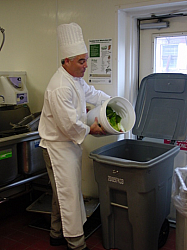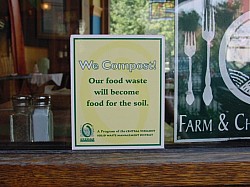July 23, 2013
Our Organics Blog Series continues with a look at commercial organics recycling.
Commercial organics waste includes food manufacturing processing residues; organic grocery discards (unsalable fruits, vegetables, and bakery goods, produce trim, soiled paper, and wax coated cardboard); and restaurant organics (“pre-consumer” food preparation scraps, “post-consumer” table scraps, and soiled a nd non-recyclable paper). Up to 90% of waste thrown out by supermarkets and restaurants is food or other organic scraps suitable for donation or composting.[1] For commercial generators, the economic incentive of reduced collection fees is a primary incentive for participating in food scrap composting.
nd non-recyclable paper). Up to 90% of waste thrown out by supermarkets and restaurants is food or other organic scraps suitable for donation or composting.[1] For commercial generators, the economic incentive of reduced collection fees is a primary incentive for participating in food scrap composting.
In order to implement commercial organics recycling, a local or regional compost operation, whether operated by private, farm, or municipal entities, will need to be willing to accept food scraps into their process, if they are not doing so already. Many compost operators are reluctant to accept food scraps, as composting these materials adds a new dynamic to the process and must be managed in specific ways so that problems do not arise. Well-managed compost operations can effectively incorporate food scraps.
Starting with a small pilot program incorporating food processor wastes, supermarket produce trimmings, or pre-consumer restaurant scraps, allows for easier integration into the compost process, monitoring, and troubleshooting. Additional processing of food scraps can be gradually phased-in. Food scraps from restaurants can have higher levels of contamination such as plastics; starting with pre-consumer scraps only (preparation discards) can help to limit this. Acceptable materials will need to be determined through discussions with the compost operation, including, whether in addition to food scraps, will the operation be willing to accept paper products and compostable plastics?
Commercial businesses are most effectively served by curbside collection, most likely provided by private haulers. Rural areas can also consider working directly with farmers to collect food scraps from commercial generators. To promote commercial organics recycling, small business generators can benefit from being allowed to use drop-off food scrap collection options (if available). Collection of food scraps by non-profit organizations using bikes[2] has also been implemented on a small scale in small towns and urban areas.
A variety of commercial organic collection options are utilized, including automated trucks with mechanized cart lifters; front loaders and dumpsters; and pick-ups, flatbed or box trucks equipped with a Tommy Lift Gate; or manual collection using carts, buckets, or compostable bags. Collection containers can range from 55-gallon drums to carts on wheels. Typically multiple collection carts are needed for onsite collection. Food scraps tend to be heavy, so containers larger than 64-gallons are seldom used. If carts are used, haulers typically provide cart cleaning services or replacement services to minimize odors and the “yuck” factor; alternatively cart liners can be inserted to keep the carts clean. In most instances collection is recommended for at least weekly or more often in the summer  to prevent odor issues.
to prevent odor issues.
Businesses in rural and small towns can also be successfully serviced through cooperative arrangements, typically the use of shared containers and hauling costs. Sharing a collection dumpster is useful for businesses in a commercial area where space is limited, as well as for businesses that may not generate sufficient quantities to justify the costs of a cart or dumpster service. In these instances, businesses benefit from decreased hauling costs and haulers benefit from reduced collection stops. The collection dumpster can be placed at a business that has sufficient space or in a shared parking lot or other location. Businesses work with the hauler to prorate the bill equitably amongst participating businesses.
Pilot projects focusing on “pre-consumer” food preparation scraps can be initiated to allow for staff training and troubleshooting of the program prior to collection of “post-consumer” food waste. Focusing on the collection of pre-consumer materials in a pilot allows for more concentrated employee training, without having to also educate customers. Pre-consumer contamination (plastics) is usually minimal and easier to eliminate through employee training.
Some businesses, including office complexes and resorts, have implemented onsite composting for food scraps and brush. These systems may prove more economical than hauling off-site, if staffing and space is available. In such settings, a commercially available in-vessel composting system or bins or shed systems are common solutions. Onsite staffing and training are required to ensure that systems are properly managed and maintained. In commercial areas onsite composting using a shared small scale in-vessel container or vermicomposting has also been used in a few urban areas and does present a possible model for rural and small towns. Commercially available worm composting units have also proven effective for handling food scraps and soiled paper from institutions and office complexes. Smaller, “homemade” worm composting bins can be constructed for use in diverting food scraps from smaller business generators.
Next up: Commercial Organics Recycling Opportunities and Action.
By Athena Lee Bradley



Comments (0)
Add a Comment